How the Dujiangyan Irrigation System Revolutionized Agriculture in Ancient China
An Essential Guide to Visiting Dujiangyan Irrigation System
Nestled amidst the breathtaking landscapes of Sichuan Province lies a marvel of ancient engineering that has withstood the test of time: the Dujiangyan Irrigation System. Dating back to 256 BC, this UNESCO World Heritage Site is not just the oldest irrigation system in the world—it’s also the only one still operating without a dam. Designed to tame the unpredictable Minjiang River, Dujiangyan transformed a flood-prone region into the fertile heart of the Chengdu Plain, forever altering the agricultural landscape of China.
In this essential guide, we will take you through the rich history and remarkable engineering of the Dujiangyan Irrigation System, exploring its three ingeniously designed components: the Yuzui, Feishayan, and Baopingkou. You’ll discover the main attractions within the scenic area, including the revered Erwang Temple, the picturesque Anlan Suspension Bridge, and the stunning views from Yulei Mountain. Whether you’re a history buff, an engineering enthusiast, or simply seeking a unique travel experience, this guide offers everything you need to know to make your visit unforgettable.
Join us on this journey to uncover the secrets of an ancient civilization that still plays a vital role in modern-day China. From practical visiting tips to the best dining options and recommended tour routes, prepare to immerse yourself in the legacy of the Dujiangyan Irrigation System, where history flows as freely as the water it diverts.
In This Guide
- An Essential Guide to Visiting Dujiangyan Irrigation System
- The Rich History and Legends of Dujiangyan Irrigation System
- Main Highlights: What You Absolutely Can’t Miss
- Planning Your Visit: A Practical Guide
- Tickets: Prices, Booking, and Tips
- How to Get There: A Complete Transportation Guide
- Local Cuisine and Accommodation Nearby
- Frequently Asked Questions
- Final Thoughts on Your Trip
The Rich History and Legends of Dujiangyan Irrigation System
An Ancient Marvel: The Origins of Dujiangyan
Nestled in the heart of Sichuan Province, the Dujiangyan Irrigation System stands as a testament to the ingenuity of ancient Chinese engineering. Established in 256 BC during the Qin Dynasty, this remarkable feat of hydraulic engineering was the brainchild of Li Bing, a local official who sought to tame the unpredictable Minjiang River. Faced with the frequent flooding that plagued the Chengdu Plain, Li Bing and his son undertook an ambitious project to transform the region from a flood-prone landscape into fertile farmland.
Through meticulous surveys and innovative techniques, the duo crafted a system that ingeniously diverted water without the need for a dam. This revolutionary approach not only stabilized agriculture but also supported the Qin state’s military campaigns, ultimately aiding in the unification of China. The success of the irrigation system was so profound that it earned the Chengdu Plain its moniker, the “Land of Abundance.”
The Legends of Li Bing
The story of the Dujiangyan Irrigation System is intertwined with the legend of its creator, Li Bing. Folklore tells of how, in his quest to control the river, Li Bing faced numerous challenges, including resistance from local residents who were skeptical of his plans. To win their trust, he demonstrated the effectiveness of his methods by successfully redirecting water to irrigate crops and sustain the community.
One of the most popular legends surrounding Li Bing involves his encounter with a powerful flood dragon, believed to be the source of the river’s violent floods. It is said that this dragon was eventually subdued by the deity Erlang, who imprisoned it beneath the waters. This legend not only highlights the cultural significance of the irrigation system but also emphasizes the harmony between nature and human ingenuity.
Enduring Legacy: The Test of Time
Fast forward over two millennia, and the Dujiangyan Irrigation System continues to showcase its brilliance. Despite enduring the ravages of time, including natural disasters like the catastrophic Wenchuan earthquake in 2008, the system remains operational, irrigating more than 1,000 square kilometers of farmland across numerous counties. UNESCO recognized this ancient marvel as a World Heritage Site in 2000, acknowledging its profound impact on agricultural development and its role in shaping the region’s culture.
Festivals and Cultural Significance
The legacy of Li Bing and the Dujiangyan Irrigation System is celebrated through various festivals held throughout the year. Among the most notable is the Qingming Water-Releasing Festival, where locals commemorate the ingenuity of Li Bing with traditional rituals and water ceremonies. The festival serves as a reminder of the enduring spirit of cooperation and community that defined the project from its inception.
In addition to its historical significance, the system continues to inspire awe in visitors today. The Erwang Temple, dedicated to Li Bing and his son, stands as a cultural landmark where ancient hydraulic principles are etched in stone, inviting travelers to reflect on the wisdom of the past.
Conclusion: A Journey Through Time
As you explore the Dujiangyan Irrigation System, you are not just witnessing an engineering marvel; you are stepping into a narrative woven with the threads of history, legend, and resilience. This ancient irrigation system is a living monument to the brilliance of human ingenuity and a symbol of the cultural heritage that continues to thrive in Sichuan. Whether you are captivated by its engineering feats or enchanted by the legends that surround it, Dujiangyan offers a rich tapestry of experiences waiting to be uncovered.
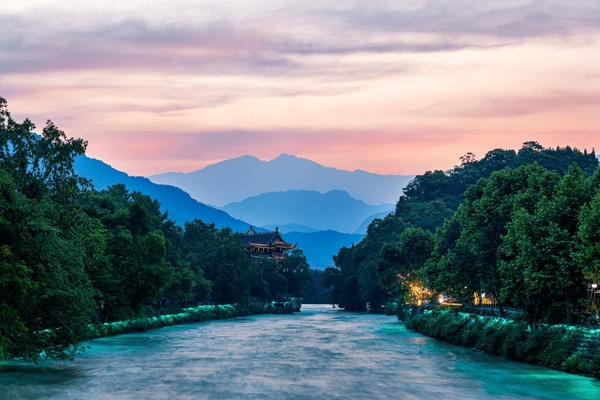
Dujiangyan Irrigation System.
Main Highlights: What You Absolutely Can’t Miss
Erwang Temple: A Tribute to Engineering Pioneers
Perched majestically on the banks of the Minjiang River, Erwang Temple is a must-visit shrine that honors the visionary engineers Li Bing and his son. This Qing Dynasty complex spreads over an impressive 50,000 square meters, featuring intricately decorated halls and lush gardens. Stand in awe of the beautifully painted statues within the Grand Hall, where ancient hydraulic principles are etched into stone. For the best views, make your way to the temple’s elevated areas—perfect for capturing the sweeping vistas of the irrigation system. Don’t miss the annual Qingming Water-Releasing Festival, where the spirit of Li Bing is celebrated with rituals that echo through the ages.
Tip: Arrive early to explore the temple grounds before the crowds descend, particularly during festival times.
Anlan Suspension Bridge: A Walk Through History
Experience a thrilling walk across the Anlan Suspension Bridge, a stunning ancient cable bridge that dates back before the Song Dynasty. Spanning the confluence of the Inner and Outer Rivers, this bridge not only offers a unique swaying experience but also serves as a picturesque backdrop for photos. As you traverse its length, be sure to take in the panoramic views of the surrounding landscape and the remarkable irrigation system below.
Tip: For the best photographs, visit during the early morning or late afternoon when the soft light casts gentle shadows over the bridge.
Yuzui (Fish Mouth Levee): Nature’s Ingenious Design
Marvel at the Yuzui, known as the Fish Mouth Levee, which ingeniously directs river flow into two channels—a brilliant feat of engineering that has functioned flawlessly for over two millennia. This V-shaped dike not only showcases the harmony of natural topography with human ingenuity but also serves as a functional divider that manages floodwaters and irrigation. As you walk along the levee, observe the subtle changes in the river’s flow and the way it sustains the agricultural backbone of the Chengdu Plain.
Tip: Bring binoculars to watch local wildlife that thrives in the ecosystems supported by the irrigation system.
Feishayan (Flying Sand Weir): Nature’s Filter
The Feishayan, or Flying Sand Weir, exemplifies smart water management with its angled spillway that prevents sediment build-up. As you wander along the riverbanks, take a moment to appreciate how this ancient structure still effectively discharges excess floodwater while using swirling currents to keep the waters clean. It’s a testament to the wisdom of the Qin engineers, demonstrating a perfect balance between utility and environmental conservation.
Tip: Visit after a rain to see the weir in action, as it skillfully manages increased water flow and sediment.
Baopingkou (Bottle-Neck Channel): The Art of Regulation
Step into the carefully crafted Baopingkou, an artificial gorge that regulates the water intake of the irrigation system. This impressive feat of engineering showcases how ancient builders understood natural water flow and sedimentation, ensuring a steady supply of irrigation water while filtering out debris. The scenic walk through this narrow channel provides a unique perspective on the intricate design and functionality of the Dujiangyan system.
Tip: Take your time here—it’s an excellent spot for photography, especially with the reflections in the water.
Yulei Mountain: Panoramic Views and History
For those seeking breathtaking views, Yulei Mountain is the perfect hiking destination. Ascend the trails leading to Yulei Pavilion, where you’ll be rewarded with sweeping vistas of the Dujiangyan Irrigation System and the Chengdu Plain. Along the way, explore the well-preserved Ming-era fortifications and the ancient trees that blanket the slopes. The mountain is not only a nature lover’s delight but also steeped in history, offering a glimpse into the region’s past.
Tip: Plan your hike for early morning or late afternoon to avoid the midday heat and enjoy the best lighting for photography.
Fulong Temple: A Serene Retreat
Nestled in Lidui Park, Fulong Temple is a tranquil escape steeped in history. Originally built to honor the Taoist master Fan Changsheng, it later became a memorial site for Li Bing. Legend has it that this site is where the deity Erlang quelled a flood dragon, adding a mystical aura to your visit. The temple’s serene ambiance, coupled with its historical significance, makes it a perfect spot for quiet reflection or a leisurely stroll.
Tip: Bring a picnic to enjoy in the park after exploring the temple; the surrounding scenery is perfect for a relaxing afternoon.
Visiting the Dujiangyan Irrigation System offers not only a lesson in ancient engineering but also a chance to appreciate the stunning landscapes and rich culture of the Sichuan region. Be prepared to immerse yourself in the history and natural beauty that surrounds this UNESCO World Heritage Site.
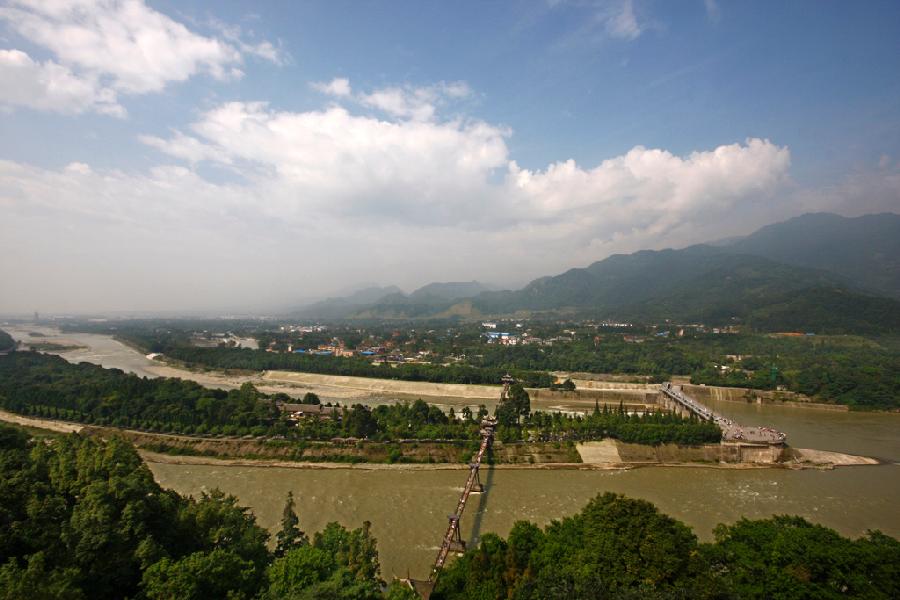
Dujiangyan Irrigation System.
Planning Your Visit: A Practical Guide
Exploring the Dujiangyan Irrigation System: A Visitor’s Guide
Nestled in the heart of Sichuan province, the Dujiangyan Irrigation System is not only a marvel of ancient engineering but also a UNESCO World Heritage Site that offers a unique glimpse into China’s rich historical and cultural tapestry. Here’s a practical guide to making the most of your visit.
Best Time to Visit
The ideal times to explore the Dujiangyan Irrigation System are spring (March to May) and autumn (September to November). During these seasons, the weather is mild, ranging from 15°C to 25°C (59°F to 77°F), which is perfect for outdoor activities. Additionally, you can experience local festivals, such as the Water-Releasing Festival in April, or enjoy the stunning golden landscapes of autumn.
It’s advisable to avoid the summer months due to heavy rainfall and sweltering heat, as well as the winter chill. For a more peaceful experience, consider visiting on weekdays to steer clear of weekend crowds, particularly during Chinese holidays like Golden Week in October.
Recommended Itinerary
Classic Route (2.5 hours)
1. Enter through Qinyan Tower (Gate 6)
2. Visit Erwang Temple – Honor the historical figures Li Bing and his son while enjoying the view.
3. Walk across Anlan Suspension Bridge – Capture iconic photos with the bridge’s swaying motion.
4. Explore Yuzui (Fish Mouth) – Witness the ingenious water diversion system.
5. Check out Feishayan Spillway – Observe the natural flow of floodwater management.
6. Visit Baopingkou – Learn about its role in the irrigation process.
7. Stop by Fulong Temple – End your journey here before exiting at Lidui Park South Gate.
In-Depth Hiking Route (3.5-4 hours)
1. Start at Gate 1 (Lidui Park)
2. Hike to Fulong Temple
3. Explore Baopingkou and Feishayan Spillway
4. Visit Yuzui and Anlan Suspension Bridge
5. Conclude at Erwang Temple – Do not miss the scenic Yulei Pavilion for panoramic views.
Photography Tips
- Golden Hours: Capture the best photographs during the early morning or late afternoon when the lighting is soft, and the colors are vibrant.
- Wide-Angle Lens: Bring a wide-angle lens to capture the expansive landscapes and intricate details of the irrigation system.
- Look for Reflections: The Minjiang River offers beautiful reflections, especially after rain. Experiment with angles to find the perfect shot.
- Candid Moments: Don’t forget to photograph local visitors and their interactions with the landscape to capture the essence of the site.
- Dramatic Perspectives: Use the elevation at Yulei Pavilion for stunning aerial views of the irrigation system and surrounding mountains.
What to Wear
- Comfortable Footwear: Due to the extensive walking and potential hiking, wear sturdy and comfortable shoes.
- Layered Clothing: The weather can vary; layering allows you to adapt to changing temperatures throughout the day.
- Sun Protection: A wide-brimmed hat, sunglasses, and sunscreen are essential, especially during sunny days.
- Rain Gear: If you visit in the rainy season, pack a lightweight rain jacket or poncho.
Insider Tips
-
Festival Participation: If your visit coincides with the Qingming Water-Releasing Festival, participate in this local event for a truly immersive experience.
-
Guided Tours: Consider joining a guided tour for deeper insights into the history and engineering of the irrigation system. Many tours include visits to nearby attractions.
-
Local Cuisine: Don’t miss out on trying local delicacies such as crispy sweet duck at Zhongyazi or explore the vibrant street food scene at Nanqiao Night Market.
-
Stay Hydrated: Carry water with you, especially if you choose the hiking route, to stay hydrated as you explore the scenic area.
-
Timing is Key: Arrive early to avoid crowds and enjoy a quieter experience, particularly at popular spots like the Anlan Suspension Bridge and Erwang Temple.
With its rich history and stunning natural landscapes, a visit to the Dujiangyan Irrigation System is not just a trip back in time; it’s an adventure that will leave you with lasting memories. Enjoy your exploration!
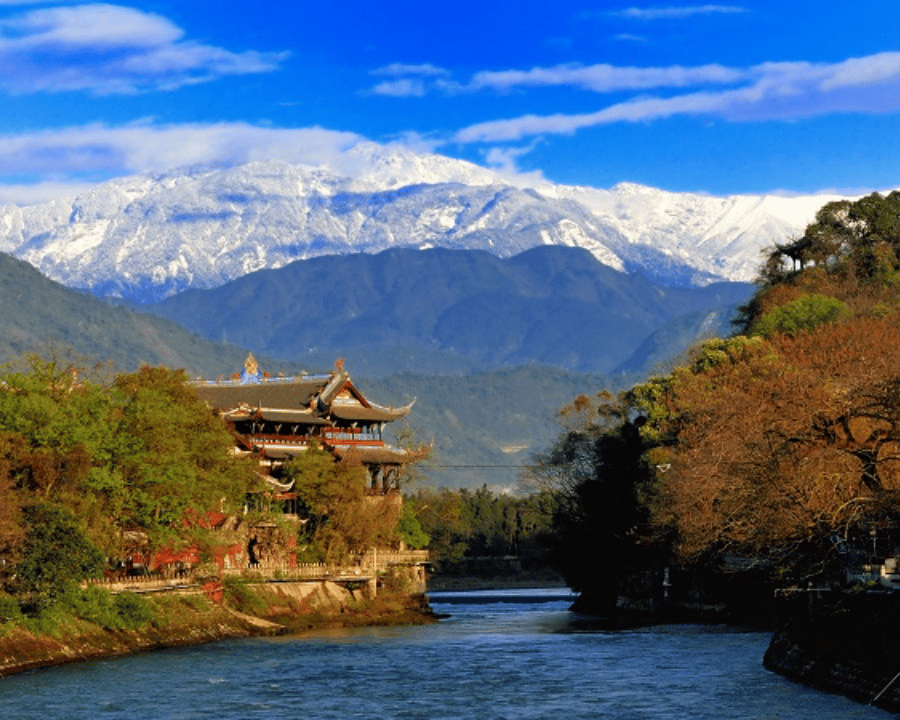
Dujiangyan Irrigation System.
Tickets: Prices, Booking, and Tips
When planning your visit to the Dujiangyan Irrigation System, understanding the ticketing details is crucial for a smooth experience. Here’s a concise overview of ticket options, prices, and what to expect:
| Ticket Type | Price (CNY) | Includes |
|---|---|---|
| Standard Admission | 80 | Access to all scenic areas and attractions within the Dujiangyan Scenic Area |
Booking Information
Tickets can be purchased at the entrance, but to ensure a hassle-free experience, especially during peak tourist seasons, it’s highly recommended to book your tickets in advance. This allows you to skip any potential long lines and secure your spot to explore this remarkable UNESCO World Heritage Site.
You can book tickets online through various travel platforms or the official Dujiangyan website. If you prefer a guided experience, consider booking a tour package that may include transportation and additional attractions, such as nearby Mount Qingcheng or the Panda Base. These options often come with the added benefit of a knowledgeable guide, enriching your visit with historical context and local insights.
Tips for a Smooth Visit
- Plan Ahead: Aim to book your tickets at least a few days in advance, especially during public holidays or weekends.
- Check Opening Hours: The site is open from 8:00 AM to 6:00 PM, giving you ample time to explore. Arriving early can help you avoid crowds and enjoy the serenity of this ancient marvel.
- Consider Weather: The best times to visit are during spring and autumn, when the weather is mild. Avoid visiting during the rainy summer months or the cold winter season for the most enjoyable experience.
- Explore the Area: Beyond just the irrigation system, make time to explore nearby attractions, such as Erwang Temple and Yulei Mountain, to fully appreciate the cultural and historical significance of the area.
By following these tips and securing your tickets in advance, you can fully immerse yourself in the awe-inspiring legacy of the Dujiangyan Irrigation System!
How to Get There: A Complete Transportation Guide
Reaching the Dujiangyan Irrigation System
The Dujiangyan Irrigation System, a marvel of ancient engineering, is conveniently located about 60 kilometers northwest of Chengdu, making it an accessible day trip for travelers. Below is a comprehensive guide on how to get there and navigate around this UNESCO World Heritage Site.
From the Nearest Major City: Chengdu
By Train:
Traveling by train is one of the most efficient and enjoyable ways to reach the Dujiangyan Irrigation System from Chengdu.
-
Metro to Xipu Railway Station: Start your journey by taking Chengdu Metro Line 2 towards Xipu Railway Station. The metro ride takes about 30 minutes.
-
High-Speed Train to Dujiangyan: Once at Xipu, transfer to a high-speed train bound for Dujiangyan. This train ride typically lasts around 30-40 minutes, with ticket prices ranging from CNY 20 to CNY 50, depending on the train class and time of day.
By Bus:
Buses are also a reliable option for getting to Dujiangyan.
-
Chengdu Bus Station Options: Head to the Chengdu Chadianzi Bus Station or Xinnanmen Bus Station. Both stations have frequent buses running to Dujiangyan.
-
Duration and Cost: The bus journey takes approximately 1.5 to 2 hours, with fares around CNY 20-30. Buses run regularly throughout the day, making this a flexible choice for travelers.
By Car:
For those who prefer the convenience of driving, renting a car or hiring a taxi can be a great option.
-
Driving Distance: The distance from Chengdu to Dujiangyan is approximately 60 kilometers, and the drive takes about 1 to 1.5 hours, depending on traffic conditions.
-
Cost of Taxi: A taxi from Chengdu to Dujiangyan may cost between CNY 200 to CNY 300 one way. If you opt for a rental car, ensure you have a GPS or a reliable map app for navigation.
Getting Around the Scenic Area
Once you arrive at the Dujiangyan Irrigation System, exploring the scenic area is both easy and enriching. Here’s how to navigate effectively:
Walking:
The primary way to experience the irrigation system and its attractions is on foot. The scenic area is well laid out, with clearly marked paths connecting key sites, including:
- Erwang Temple
- Anlan Suspension Bridge
- Yuzui (Fish Mouth)
- Feishayan Spillway
- Baopingkou
Most visitors spend about 3 to 4 hours on foot, enjoying the beautiful landscapes and historical landmarks.
Local Shuttle Buses:
For those who prefer not to walk the entire distance, there are local shuttle buses within the scenic area that can transport you between major attractions. Each ride typically costs around CNY 5-10.
Bicycle Rentals:
Some visitors enjoy renting bicycles to cover more ground while appreciating the scenery. Check local shops near the entrance for rental options.
Guided Tours:
If you want a more in-depth experience, consider joining a guided tour. Many tours include transportation, knowledgeable guides, and visits to other nearby attractions like Mount Qingcheng, ensuring a well-rounded experience.
Conclusion
Whether you choose to travel by train, bus, or car, getting to the Dujiangyan Irrigation System is straightforward and well worth the effort. Once there, the scenic area offers a variety of ways to explore this historical wonder, making it a memorable addition to your travels in China.
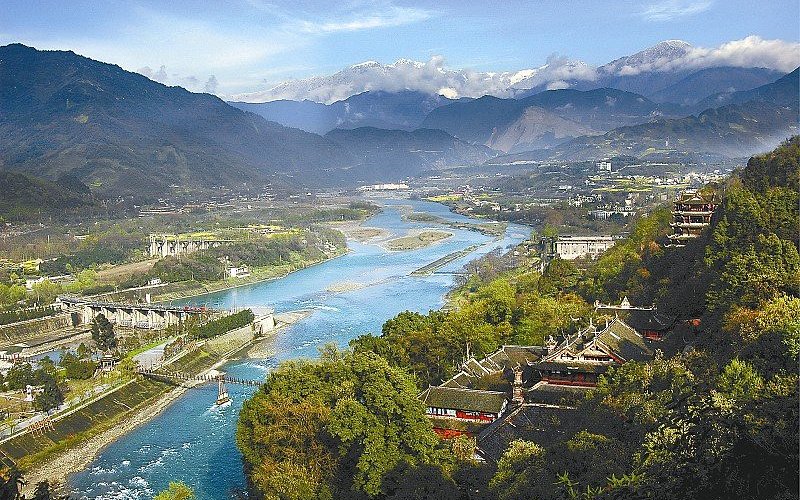
Dujiangyan Irrigation System.
Local Cuisine and Accommodation Nearby
Visiting the Dujiangyan Irrigation System is not just about witnessing a marvel of ancient engineering; it’s also an opportunity to indulge in the rich culinary traditions of Sichuan Province and find the perfect place to rest after a day of exploration. Here are some local dining delights and accommodation options nearby that cater to various preferences.
Culinary Delights
-
Crispy Sweet Duck (脆皮甜鸭)
A local specialty, this dish features duck that is marinated and then roasted to perfection, yielding a crispy skin and succulent meat. The sweetness of the marinade balances beautifully with the savory flavors, making it a must-try at Zhongyazi, a popular restaurant located in Guanxian Ancient Town. -
Spicy Duck Feet (香辣鸭爪)
For the adventurous eater, spicy duck feet are a unique treat. These are typically marinated in a spicy, tangy sauce and are often enjoyed as a snack or appetizer. The combination of flavors and textures will tantalize your taste buds and give you a true taste of Sichuan’s bold culinary style. -
Brown Sugar Rice Balls (红糖汤圆)
After savoring the savory dishes, don’t miss out on dessert! These sweet treats are made from glutinous rice flour and filled with brown sugar syrup. They are served warm and often come in a sweet broth, making them the perfect way to end your meal. -
Leaf-Wrapped Rice Cakes (粽子)
A traditional snack in the region, these rice cakes are wrapped in bamboo leaves and filled with a mixture of sticky rice and various fillings, such as meats or sweet ingredients. They are steamed to perfection and make for an excellent on-the-go snack as you explore the scenic area.
Accommodation Options
Luxury Stay:
– Dujiangyan InterContinental Resort
Nestled in the lush landscape near the irrigation system, this five-star hotel offers luxurious accommodations with stunning views. Guests can enjoy world-class amenities, including a spa, fine dining, and spacious rooms designed for ultimate comfort.
Boutique Experience:
– The Lodge at Mount Qingcheng
This charming boutique hotel combines modern comfort with traditional Chinese aesthetics. Located a short distance from Dujiangyan, it offers cozy rooms and personalized service, making it perfect for travelers seeking a unique experience amidst nature.
Budget-Friendly Choice:
– Hostel Dujiangyan
If you’re looking for a budget-friendly option, consider the local hostel that provides clean, comfortable dormitory-style accommodations. It’s a great place to meet fellow travelers and share stories after a day of exploration.
Whether you’re indulging in the rich flavors of local cuisine or finding a relaxing place to stay, Dujiangyan offers a delightful blend of experiences that enhance your visit to this UNESCO World Heritage Site.
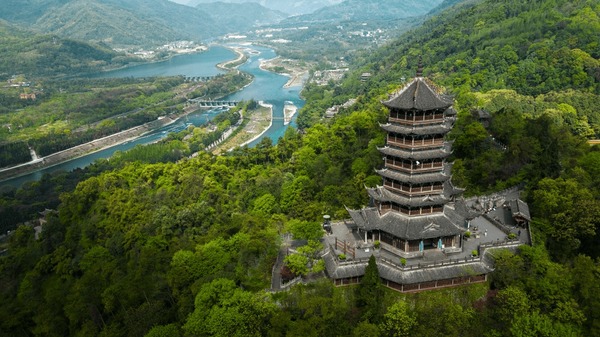
Dujiangyan Irrigation System.
Frequently Asked Questions
Frequently Asked Questions about Dujiangyan Irrigation System
1. Is the Dujiangyan Irrigation System suitable for children and the elderly?
Yes, the Dujiangyan Irrigation System is suitable for families, including children and the elderly. The main scenic areas are accessible, and there are relatively flat walking paths. However, some hiking routes, especially those leading to Yulei Pavilion, may be challenging for those with limited mobility. It’s advisable to choose the classic route if you’re visiting with older adults or young children.
2. Are there English signs and guides available?
Yes, there are English signs throughout the Dujiangyan Irrigation System, providing information about the various attractions and features. Additionally, you can find English-speaking guides available for hire at the entrance or through local tour agencies, which can enhance your understanding of this historical site.
3. How much time should I plan for a visit?
We recommend setting aside about 3 to 4 hours to fully enjoy the Dujiangyan Irrigation System. This timeframe allows you to explore the key attractions, take photographs, and appreciate the engineering marvel at a leisurely pace. If you opt for a more in-depth hiking route, consider extending your visit to 4 to 5 hours.
4. What are the best times of year to visit?
The ideal seasons to visit are spring (March to May) and autumn (September to November). During these months, the weather is mild, with temperatures ranging from 15 to 25°C (59 to 77°F), making it pleasant for outdoor exploration. Avoid the summer months due to heavy rains and winter when temperatures can drop significantly.
5. Is there an entrance fee?
Yes, the entrance fee for the Dujiangyan Irrigation System is CNY 80 (approximately USD 12). It’s advisable to check for any potential changes in pricing or special discounts that may be available during your visit.
6. Are food and drink options available on-site?
Yes, there are various dining options available around the area, including local eateries serving traditional Sichuan cuisine. You can savor local specialties such as crispy sweet duck and spicy duck feet. There are also snack stalls offering traditional snacks. However, it’s a good idea to bring some water, especially if you plan on hiking.
7. How do I get to the Dujiangyan Irrigation System from Chengdu?
To reach the Dujiangyan Irrigation System from Chengdu, take metro line 2 to Xipu Railway Station, and then transfer to a high-speed train to Dujiangyan. The journey takes approximately 1 to 1.5 hours. Alternatively, you can opt for a taxi or book a guided tour that includes transportation.
8. Are there any specific events or festivals to consider during my visit?
Yes, the Dujiangyan Irrigation System hosts several festivals throughout the year. Notably, the annual Water-Releasing Festival in April is an exciting event that showcases the irrigation system in action. If you’re interested in cultural experiences, planning your visit around this festival can offer a unique perspective on the site’s significance.
Final Thoughts on Your Trip
As you wrap up your exploration of the Dujiangyan Irrigation System, take a moment to reflect on the incredible journey you’ve undertaken. This ancient marvel, which has stood the test of time for over two millennia, is not just a testament to the brilliance of ancient Chinese engineering but also a living reminder of the harmony between humans and nature.
Walking through the scenic area, you’ve witnessed firsthand how ingenuity can transform a landscape, turning flood-prone land into the “Land of Abundance.” The breathtaking views from Yulei Mountain, the cultural richness of Erwang Temple, and the thrill of crossing the Anlan Suspension Bridge are experiences that linger long after you’ve left.
As you depart, consider how the Dujiangyan Irrigation System embodies resilience and innovation. Let it inspire you to appreciate the wonders of human creativity and the importance of sustainable practices in our modern world. Whether you’re savoring local delicacies or capturing picturesque moments, carry the spirit of Dujiangyan with you, and remember: every journey holds the potential for discovery and connection, not just to the places you visit, but to the stories they tell. Safe travels!